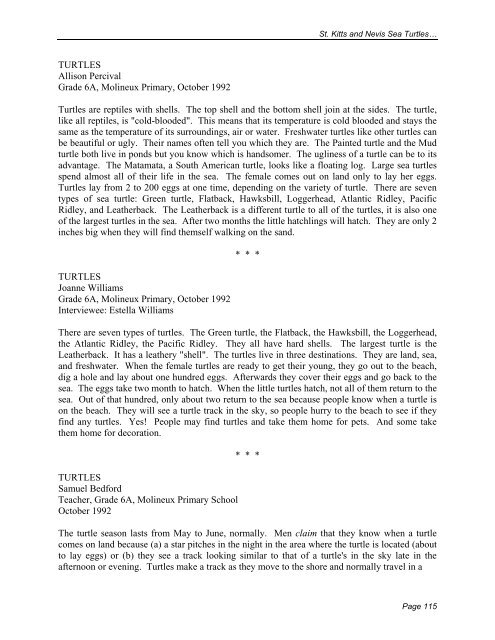Sea Turtle Recovery Action Plan for St. Kitts and Nevis - WIDECAST
Sea Turtle Recovery Action Plan for St. Kitts and Nevis - WIDECAST
Sea Turtle Recovery Action Plan for St. Kitts and Nevis - WIDECAST
You also want an ePaper? Increase the reach of your titles
YUMPU automatically turns print PDFs into web optimized ePapers that Google loves.
<strong>St</strong>. <strong>Kitts</strong> <strong>and</strong> <strong>Nevis</strong> <strong>Sea</strong> <strong>Turtle</strong>s…<br />
TURTLES<br />
Allison Percival<br />
Grade 6A, Molineux Primary, October 1992<br />
<strong>Turtle</strong>s are reptiles with shells. The top shell <strong>and</strong> the bottom shell join at the sides. The turtle,<br />
like all reptiles, is "cold-blooded". This means that its temperature is cold blooded <strong>and</strong> stays the<br />
same as the temperature of its surroundings, air or water. Freshwater turtles like other turtles can<br />
be beautiful or ugly. Their names often tell you which they are. The Painted turtle <strong>and</strong> the Mud<br />
turtle both live in ponds but you know which is h<strong>and</strong>somer. The ugliness of a turtle can be to its<br />
advantage. The Matamata, a South American turtle, looks like a floating log. Large sea turtles<br />
spend almost all of their life in the sea. The female comes out on l<strong>and</strong> only to lay her eggs.<br />
<strong>Turtle</strong>s lay from 2 to 200 eggs at one time, depending on the variety of turtle. There are seven<br />
types of sea turtle: Green turtle, Flatback, Hawksbill, Loggerhead, Atlantic Ridley, Pacific<br />
Ridley, <strong>and</strong> Leatherback. The Leatherback is a different turtle to all of the turtles, it is also one<br />
of the largest turtles in the sea. After two months the little hatchlings will hatch. They are only 2<br />
inches big when they will find themself walking on the s<strong>and</strong>.<br />
TURTLES<br />
Joanne Williams<br />
Grade 6A, Molineux Primary, October 1992<br />
Interviewee: Estella Williams<br />
* * *<br />
There are seven types of turtles. The Green turtle, the Flatback, the Hawksbill, the Loggerhead,<br />
the Atlantic Ridley, the Pacific Ridley. They all have hard shells. The largest turtle is the<br />
Leatherback. It has a leathery "shell". The turtles live in three destinations. They are l<strong>and</strong>, sea,<br />
<strong>and</strong> freshwater. When the female turtles are ready to get their young, they go out to the beach,<br />
dig a hole <strong>and</strong> lay about one hundred eggs. Afterwards they cover their eggs <strong>and</strong> go back to the<br />
sea. The eggs take two month to hatch. When the little turtles hatch, not all of them return to the<br />
sea. Out of that hundred, only about two return to the sea because people know when a turtle is<br />
on the beach. They will see a turtle track in the sky, so people hurry to the beach to see if they<br />
find any turtles. Yes! People may find turtles <strong>and</strong> take them home <strong>for</strong> pets. And some take<br />
them home <strong>for</strong> decoration.<br />
TURTLES<br />
Samuel Bed<strong>for</strong>d<br />
Teacher, Grade 6A, Molineux Primary School<br />
October 1992<br />
* * *<br />
The turtle season lasts from May to June, normally. Men claim that they know when a turtle<br />
comes on l<strong>and</strong> because (a) a star pitches in the night in the area where the turtle is located (about<br />
to lay eggs) or (b) they see a track looking similar to that of a turtle's in the sky late in the<br />
afternoon or evening. <strong>Turtle</strong>s make a track as they move to the shore <strong>and</strong> normally travel in a<br />
Page 115
















